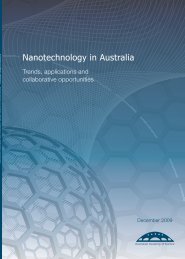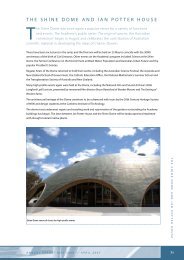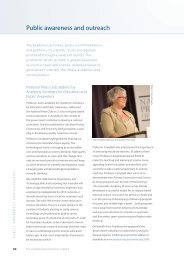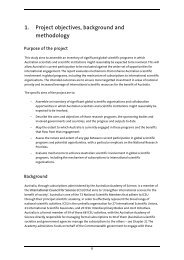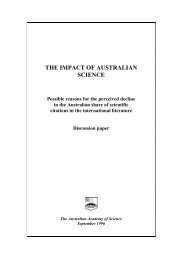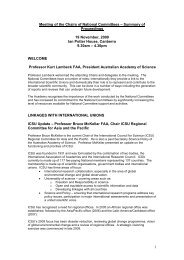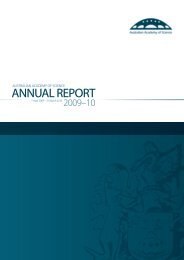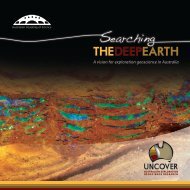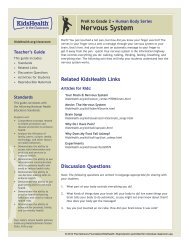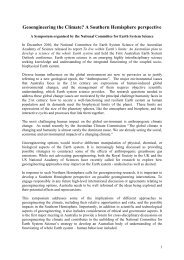Australia's Major National Research Facilities - Australian Academy ...
Australia's Major National Research Facilities - Australian Academy ...
Australia's Major National Research Facilities - Australian Academy ...
Create successful ePaper yourself
Turn your PDF publications into a flip-book with our unique Google optimized e-Paper software.
X-Series Expansion tubes combine the free piston driver technique with the expansion tube concept of cascading shock tunnels to<br />
achieve superorbital velocities. The primary purpose of these facilities is to create the high speeds encountered by interplanetary reentry<br />
vehicles during aero braking. This is a field where design uncertainty factors of 450% are encountered, and experimental data is<br />
sparse. Flight up to simulated speeds of 14.5 km/s (52000 km/hr) have been achieved. Appropriate mixtures of test gas are used to<br />
simulate the atmospheres of various planets and moons. These facilities have also been shown to be useful for scramjet testing at lower<br />
speeds, due to their very high total pressure simulation capability.<br />
Drummond shock tunnel is a small shock tunnel with a fixed driver in which initiation of a shot is made by piercing the primary<br />
diaphragm. It is presently being used to investigate contoured nozzle design for larger facilities. The test section has good optical<br />
access with four 100 mm diameter quartz windows.<br />
The Laser Diagnostics is working on the development and application of advanced measurement techniques to high enthalpy flows,<br />
flames and plumes. The aim is to characterise such flows by the use of non-intrusive laser-based methods. Two tunable pulsed dyelaser<br />
systems and an intensified camera are available for spectroscopic applications while a pulsed Nd:YAG laser is used for<br />
interferometric methods. A number of techniques are being used for flow visualisation and for measurement of conditions such as<br />
velocity, density and temperature.<br />
(V) Participation in international projects<br />
European Organisation for Nuclear <strong>Research</strong> (CERN)<br />
Collaboration is shaped by a Memorandum of Understanding between the <strong>Australian</strong> Centre for High Energy Physics and CERN, for<br />
the ATLAS project. Experiments include the origin of mass, the origin of asymmetry between particles and antiparticles, and the<br />
masses of neutrinos.<br />
Japanese <strong>National</strong> Physics Laboratory (KEK)<br />
Collaboration with KEK is involves similar experimental approaches to that for CERN.<br />
Psychology<br />
We believe that this will be possible, in consultation with HODSPA and other bodies.<br />
Radio Science Yes, and that will be covered by the national Radio Science plan to be produced in next 12 months.<br />
Can the likely personnel requirements of the discipline be determined over the timeframe identified for the planning process?<br />
Astronomy<br />
Biomedical<br />
Sciences<br />
Chemistry<br />
Yes, that is one of the aims of the Decadal Plan.<br />
Again this would be a big task and we are not sure where we would start with it. In summary this assessment would not be possible<br />
without having a comprehensive knowledge of the funding available in the various sectors comprising the constituency of the NCBS<br />
and some input from relevant institutions.<br />
Yes, providing it is done in conjunction with other bodies. The anticipated RACI/NCC review during 2004/05 is likely to cover this<br />
item.<br />
34



